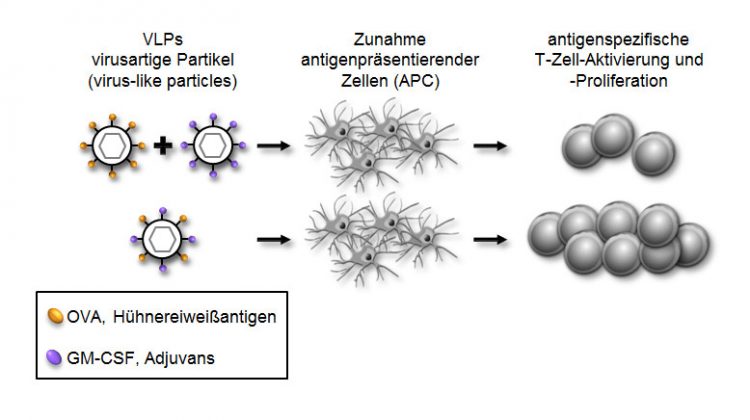Modular virus-like particles as vaccine platform?

The combination of antigen+adjuvant in virus-like particles trigger enhanced immune responses as compared to separate delivery of these components. This can be used for the development of new vaccines Source: PEI
So-called modular vaccines in which the antigen – the pathogen component against which the immune protection is to be developed – is physically connected (conjugated) to the adjuvant (effect enhancer) convey a significantly stronger immune response than vaccines in which the components are present separately. Modular vaccines are thus particularly immunogenic. The reason for this improved effect is probably the simultaneous transport of both components to the antigen presenting cells.
Can the effectiveness of those vaccines which are based on virus-like particles (VLPs) also be enhanced by such a modular construction? A research group of Dr. Zoe Waibler, head of Section 'Product Testing of Immunological Biomedicines' of Division Immunology at the Paul-Ehrlich-Institut (PEI) has investigated this question jointly with researchers of the research group 'Molecular Allergology' and Section 'Product Testing of Immunological Biomedicines', also at the PEI.
Vaccines based on virus particles are of interest because the immune system responds directly to virus particles as part of the normal defence against infections. VLPs already present the basis for vaccines authorised in Europe for the protection against human papilloma viruses.
VLPs do not contain any nucleic acids and cannot replicate in the target cells. Certain VLPs are also an attractive platform for vaccine development because new vaccines can be created from them by interchanging the antigen. Besides, the antigen and the adjuvant can be presented to the immune system on their surface simultaneously.
The researchers of the PEI used chicken egg white (ovalbumin) as model antigen and GM-CSF (granulocyte macrophage-colony stimulating factor) as adjuvant. The receptor for this cytokine can be found on various immune cells which present the antigen to additional immune cells, thus triggering an immune response.
The researchers used various approaches to prove that these modular VLPs activate important immune cells (T-helper cells and cytotoxic T cells). And this stimulation turned out to be significantly stronger if both adjuvant and antigen were presented jointly on these VLPs.
In the next steps, the PEI researchers will check the effects observed in the cell cultures in an animal model and will examine whether protection from defined pathogens can be conveyed using the VLPs thus obtained.
Original Publication
DOI: https://doi.org/10.1016/j.molimm.2018.05.017
Gogesch P, Schülke S, Scheurer S, Mühlebach MD, Waibler Z (2018):
Modular MLV-VLPs co-displaying ovalbumin peptides and GM-CSF effectively induce expansion of CD11b+ APC and antigen-specific T cell responses in vitro.
Mol Immunol Maqy 28 [Epub ahead of print]
The Paul-Ehrlich-Institut, the Federal Institute for Vaccines and Biomedicines, in Langen near Frankfurt/Main is a senior federal authority reporting to the Federal Ministry of Health (Bundesministerium für Gesundheit, BMG). It is responsible for the research, assessment, and marketing authorisation of biomedicines for human use and immunological veterinary medicinal products. Its remit also includes the authorisation of clinical trials and pharmacovigilance, i.e. recording and evaluation of potential adverse effects.
Other duties of the institute include official batch control, scientific advice and inspections. In-house experimental research in the field of biomedicines and life science form an indispensable basis for the manifold tasks performed at the institute.
The Paul-Ehrlich-Institut, with its roughly 800 members of staff, also has advisory functions nationally (federal government, federal states (Länder)), and internationally (World Health Organisation, European Medicines Agency, European Commission, Council of Europe etc.).
https://www.sciencedirect.com/science/article/pii/S0161589018301640 – Fulltext with link to the pdf-Version (available until July 17)
https://www.ncbi.nlm.nih.gov/pubmed/29852456 – Publication Abstract
https://www.pei.de/EN/information/journalists-press/press-releases/2018/09-modul… – This press release on the Paul-Ehrlich-Institut Website
Media Contact
All latest news from the category: Life Sciences and Chemistry
Articles and reports from the Life Sciences and chemistry area deal with applied and basic research into modern biology, chemistry and human medicine.
Valuable information can be found on a range of life sciences fields including bacteriology, biochemistry, bionics, bioinformatics, biophysics, biotechnology, genetics, geobotany, human biology, marine biology, microbiology, molecular biology, cellular biology, zoology, bioinorganic chemistry, microchemistry and environmental chemistry.
Newest articles

First-of-its-kind study uses remote sensing to monitor plastic debris in rivers and lakes
Remote sensing creates a cost-effective solution to monitoring plastic pollution. A first-of-its-kind study from researchers at the University of Minnesota Twin Cities shows how remote sensing can help monitor and…

Laser-based artificial neuron mimics nerve cell functions at lightning speed
With a processing speed a billion times faster than nature, chip-based laser neuron could help advance AI tasks such as pattern recognition and sequence prediction. Researchers have developed a laser-based…

Optimising the processing of plastic waste
Just one look in the yellow bin reveals a colourful jumble of different types of plastic. However, the purer and more uniform plastic waste is, the easier it is to…



